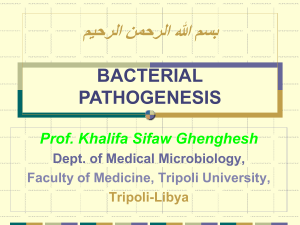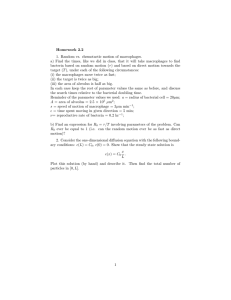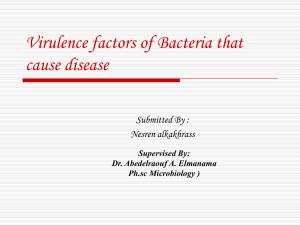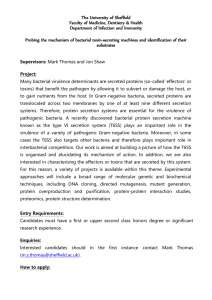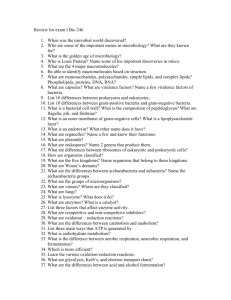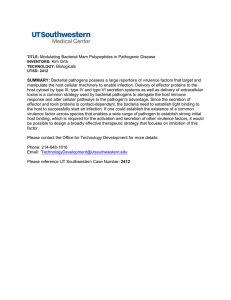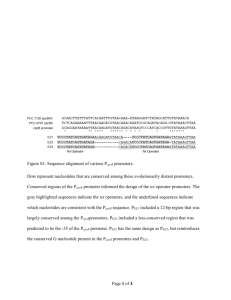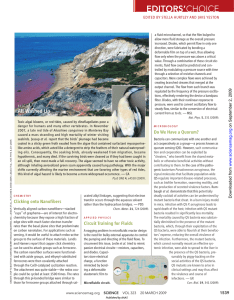Space flight alters bacterial gene expression and
advertisement
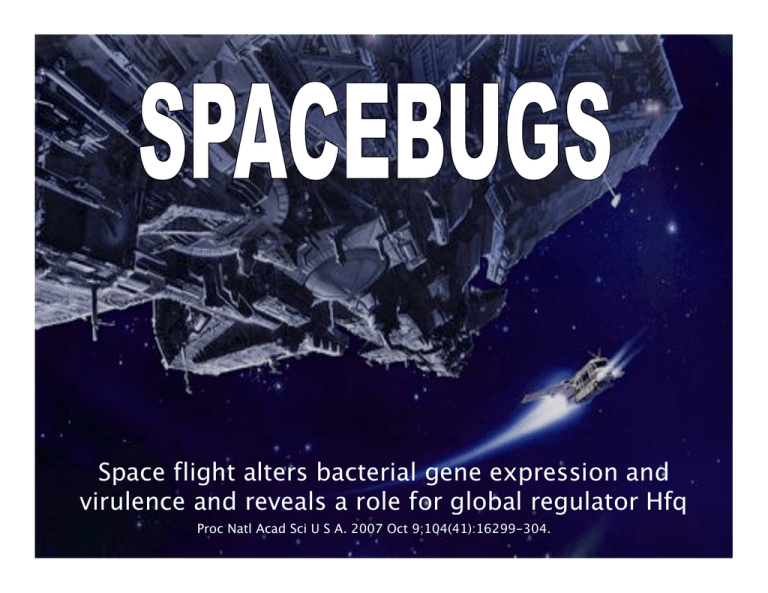
Space flight alters bacterial gene expression and virulence and reveals a role for global regulator Hfq Proc Natl Acad Sci U S A. 2007 Oct 9;104(41):16299-304. “Space sick: What bugs us on Earth gets worse in orbit” “Germs sent to space come back meaner, scientist reports” “A New Reason to Fear Space Germs” “Bacteria Grown in Space Become More Deadly” “Lethal Bacteria Turn Deadlier After Space Travel” Why Study Bacteria In Space? •Manned Missions •Spacecraft •Decontamination •Insight to physiology on Earth Bacteria Make Spacecraft “Sick” •Bacterial Contamination •Window Gaskets •Cable Insulations Mir Space Station •Wire insulations •Space suits •Possible Complication •Corrosion of insulation •Electrical failure Fungal contamination in Mir •Structural failure Bacteria Make Astronauts Sick Astronauts have impaired immune system in space PKA Pathway Disrupted 91 genes non-induced 8 genes inactivated Reduces activation of T-Cells Level of compromised T-Cell function only known in 2 situations 1. Weightlessness 2. HIV Infection Antibiotics in Space Not-well tested Limitations on drug studies •Expensive $$$ •Experimental parameters differ between missions •Immune Response factors hard to replicate •Stress, radiation exposure, reduced gravity •Drug stability in space Shuttle does carry aide kits Health maintenance Emergency situations Space flight alters bacterial gene expression and virulence and reveals a role for global regulator Hfq •This Paper focuses on experiments from Shuttle Mission STS-115 •Based of previous studies by Nickerson and colleagues at ASU and Tulane •Salmonella subjected to LSMMG is more virulent •Acid/Thermal Stress •Survival in Macrophages Evidence for Microgravity Affecting Salmonella Virulence Microgravity as a Novel Environmental Signal Affecting Salmonella enterica Typhimurium Virulence Infection and Immunity, June 2000, p. 3147-3152 Microarray analysis identifies Salmonella genes belonging to the low-shear modeled microgravity regulon PNAS. October 15, 2002, vol 99, no. 21, p. 13807-13812 Salmonella enterica Serovar Typhimurium • Gram negative rod bacterium • Causes gastroenteritis in humans • Causes systemic disease in mice – Similar to Typhoid fever in humans X Design of HARV High-aspect-ratio rotating well vessel bioreactor Bacterial cell suspension Growth Conditions • Cells grown overnight in Lennox broth at 37ºC • Diluted 1:200 into 50 ml LB and added to HARV ensuring entire vessel was full • Cells were grown to mid-log (~10 h) – 1 x g conditions – LSMMG conditions Virulence in BALB/c Mice Gravity LSMMG Condition LD50 1xg 2.2 x 107 LSMMG 4.3 x 106 5 mice per dose Trial carried out over 10 days Oral inoculation 1.9 x 106 CFU Acid Stress Survival Gravity LSMMG Cells Subjected to Citrate buffer pH 3.5 Dilutions performed at time intervals to determine CFU/ml Survival in Macrophages 1xg • Salmonella added to well plates with monolayer of J774 macrophage cells LSMMG • Cells were incubated with macrophages for 1h • Cells washed with PBS & incubated with MEM media with gentamicin • Macrophages were lysed and viable cells were counted LSMMG Cells are prepared for initial stresses within macrophages LSMMG Increases Virulence • Cells grown under LSMMG have increased virulence – Increased resistance to acid stress – Increased survivability on macrophages – Increased virulence in mice • What genes are causing this change? Microarray analysis revels genes regulated by LSMMG • 163 genes found to be regulated by LSMMG – – – – – Transcriptional regulators Virulence factors Iron-utilization enzymes LPS biosynthetic enzymes Unknown proteins • Looked and RpoS – Primary σ-factor for stress response in Salmonella – Essential for virulence in mice RpoS NOT Involved in LSMMG Stress Response • An RpoS mutant shows the same response to stresses as WT in LSMMG conditions – – – – – Resistance to acid stress Resistance to high salt Resistance to high temperatures Increased survival in macrophages Increased virulence in mice • If RpoS involved in LSMMG response would expect to see a decrease in stress resistance and virulence MISSION STS-115 Shuttle Mission STS-115 Have shown Salmonella to have increased virulence in mimicked LSMMG on Earth Is this the same in real space conditions? Designed an experiment flown on Atlantis Mission STS-115 on September 9, 2006 STS-115 • Primary goal was to build onto the international space station • Added a solar panel truss which doubled the power generating capacity of the station • Required 3 space walks over 4 days “MICROBE” • Tested microgravity environments on three different organisms – Salmonella typhimurium – Pseudomonas aeruginosa – Candida albicans • Experiments carried out in a fluid processing apparatus • Operated by crew member using a hand crank • Ground experiments carried out simultaneously Fluid Processing Apparatus FPA At Work Fixative or LB Bacteria LB Media 1st Crank 2nd Crank Bacteria dispensed into LB Fixative/LB dispensed into LB/Bacteria FPA At Work Fixative or LB Bacteria LB Media 1st Crank 2nd Crank Bacteria dispensed into LB Fixative/LB dispensed into LB/Bacteria MICROBE • On day 9 crew cranked FPA releasing Salmonella into LB medium • 24h post inoculation crew cranked FPA releasing Fixative or fresh Broth • When the shuttle landed fixed samples were frozen and fresh cultures were subjected to animal testing Increased Virulence in Space Flight Microarray Reveals hfq Involvement in LSMMG • hfq expression decreased in flight • Expression of 64 genes altered in flight that belong to hfq regulon • Interesting Down Regulated Genes – – – – dps (Ferritin and stress response protein) fnr (Transcriptional regulator) Bfr (Bacerioferritin, iron storage) ALL found to be required for virulence • What is Hfq? Hfq • First identified as requirement for Q_ RNA phage replication • Crystal structure shows homohexamer • Regulates translation by: – masking Shine-Dalgarno (ex: hfq) – matchmaking of small untranslated RNAs to target transcripts (ex: ryhB – sodB) – mRNA stability (ex: RNase E, and other mRNA decay enzymes) • Sm-like (Lsm) protein – Spliceosome in eukaryotes Sauter, C. et al. Nucleic Acids Res 31:4091-4098 Hfq and Eukaryotic Similarities • Sm proteins involved in splicing of mRNA – Sm autoantibodies discovered in lupus patients • More than 16 Lsm proteins discovered in eukaryotes – processing mRNAs, snoRNAs, tRNAs, rRNAs, snRNPs of histone mRNA – present in bacteria and archaea Comparison of Hfq and Lsm Cellular Interactions Wilusz, CJ and Wilusz J. 2005. Nat Struct Mol Bio 12:1031-1036 Organization of Hfq Gene Region E. coli K12 S. typhimurium LT2 P2Hfq P3Hfq P1Hfq PHfq • Expression of Hfq dependent on growth - evidence from pulse chase experiments Kajatani M. et al. 1994. J Bacteriol176:531-534 _ Hfq __’ Involvement of Hfq in LSMMG Stress Response • Created three mutant strains – Deletion of hfq with CMr cassette – Fusion of CMr cassette downstream of hfq – Deletion of invA (Unrelated to stress resistance) • Tested effects of LSMGG on – Acid resistance – Survival in macrophages Acid Resistance Salmonella cells incubated with citrate buffer (pH3.5) 60min Calculated % survival Graph represents fold difference in survival between gravity and microgravity Survival in Macrophages • Cells incubated with J774 macrophages for 2h and 24h • # of viable bacteria counted by CFU/ml • Graph represents fold difference between time points Conclusions • First documented results showing altered gene expression in space flight • Microgravity is a environmental signal that causes changes in cell behavior • Hfq is a global regulator of responses under LSMMG conditions Questions • What is the mechanism of Hfq regulation? • How long does this increased virulence last?
